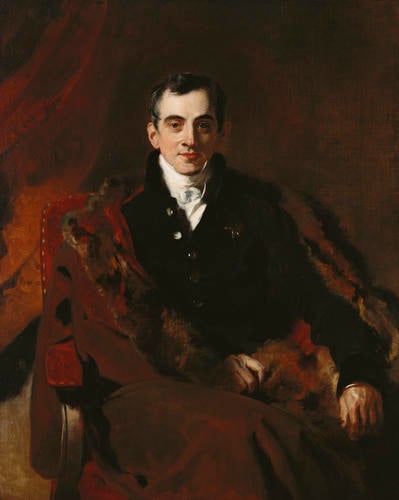-
1 of 253523 objects
John, Count Capo d'Istria (1776-1831) 1818-19
Oil on canvas | 128.4 x 102.8 cm (support, canvas/panel/stretcher external) | RCIN 404947
-
Lawrence was the most fashionable and also the greatest portraitist of his generation. He was made Principal Painter to George III in 1792 after Reynolds’s death, and received occasional commissions; however it was only after 1814 that George IV began to employ him in earnest. This portrait was commissioned by George IV at a cost of 300 guineas; it was painted at the Congress of Vienna in 1818-9, where the Capo d’Istria was Plenipotentiary for Russia and seems to have always been intended for what became the 'Waterloo Chamber'. The sitter wears a fur-lined cloak and a star, probably of the Order of St Alexander Nevski. Many characteristics of this portrait recall Rembrandt’s self-portraits: the frontal posture and direct stare, the simple geometry of the features (with exactly circular eye-sockets), the loose finish and deep shadows of the background. This may be intended to give the sitter a manly openness of manner: Capo D’Istria was certainly an admirable as well as enterprising character, rising through his own abilities in the service of the Septinsular Republic and Imperial Russia before in 1827 accepting the position of the first President of the newly-formed Republic of Greece. He was murdered by a local war-lord. The Waterloo Chamber is a great hall on the public route at Windsor Castle displaying portraits of those soldiers, sovereigns and diplomats responsible for the overthrow of Napoleon and the re-establishment of the monarchies and states of Europe thereafter. The concept began in 1814 when George IV used the opportunity of the Treaty of London to commission Lawrence to paint distinguished visitors. The group of portraits grew during the next decade as Lawrence continued to obtain portrait sittings at the various congresses following the Battle of Waterloo in 1815 and, in some cases, by making special journeys. Most of the twenty eight portraits were delivered after his death on 7 January 1830. By this time work was already begun of the space of the Waterloo Chamber created by covering a courtyard at Windsor Castle with a huge sky-lit vault; the room was completed during the reign of William IV (1830-7). The first illustration of the interior is provided by Joseph Nash (1809-78) in 1844 (RCIN 919785) and shows the arrangement which survives to this day: full-length portraits of warriors hang high, over the two end balconies and around the walls; at ground level full-length portraits of monarchs alternate with half-lengths of diplomats and statesmen. Three-quarter length portrait of John, Count Capo d'Istria (1776-1831), facing slightly to the right, seated in an armchair, wearing a fur-lined cloak and a star, probably of the Order of St Alexander Nevski, on his breast
Provenance
Painted in Vienna for George IV, when Prince Regent for 300 guineas; added to the inventory of Carlton House dated 1819 (no 668); taken to the Waterloo Chamber at Windsor Castle
-
Medium and techniques
Oil on canvas
Measurements
128.4 x 102.8 cm (support, canvas/panel/stretcher external)
127.3 x 100.7 cm (sight)
153.2 x 127 x 9.4 cm (frame, external)
Category
Object type(s)
